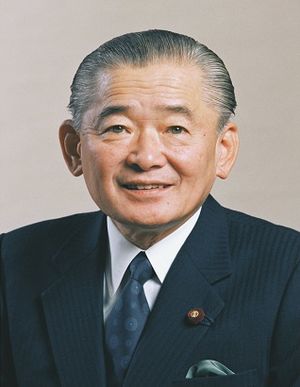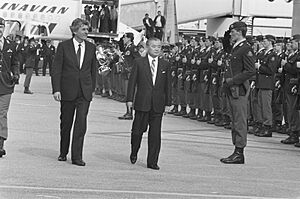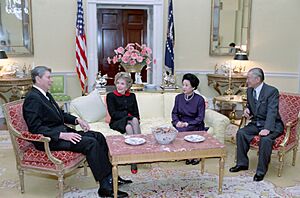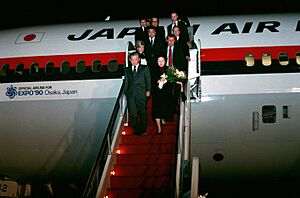Noboru Takeshita facts for kids
Quick facts for kids
Noboru Takeshita
|
|
|---|---|
| 竹下 登 | |
 |
|
| Prime Minister of Japan | |
| In office 6 November 1987 – 3 June 1989 |
|
| Monarch | Shōwa Akihito |
| Deputy | Kiichi Miyazawa |
| Preceded by | Yasuhiro Nakasone |
| Succeeded by | Sōsuke Uno |
| Member of the House of Representatives | |
| In office 22 May 1958 – May 2000 |
|
| Personal details | |
| Born | 26 February 1924 Kakeyama, Shimane Prefecture, Empire of Japan |
| Died | 19 June 2000 (aged 76) Minato, Tokyo, Japan |
| Political party | Liberal Democratic Party |
| Alma mater | Waseda University |
| Signature |  |
Noboru Takeshita (竹下 登, Takeshita Noboru; February 26, 1924 – June 19, 2000) was an important politician in Japan. He served as the Prime Minister of Japan from 1987 to 1989. This was a time when Japan's economy was growing very fast, often called the "bubble economy."
Takeshita led the biggest group, or "faction," within the Liberal Democratic Party. He took over this group from Kakuei Tanaka in the 1980s and remained a powerful figure until his death. People sometimes called him the "last shadow shogun" because he had a lot of influence behind the scenes in Japanese politics. He was also the last prime minister to serve while Emperor Shōwa was still the emperor. His grandson is the famous musician and actor Daigo.
Contents
Early life and education
Noboru Takeshita was born on February 26, 1924, in a place now called Unnan, in Shimane Prefecture, Japan. His family had made sake (a Japanese drink) for many generations. Noboru was the 20th head of his family's sake business. Both his father and grandfather were well-respected people in their area. Takeshita decided to follow in their footsteps and become a politician when he was in middle school.
He went to Waseda University in Tokyo. Before joining the Imperial Japanese Army to serve as an instructor during World War II, he got married. After the war, he married again, to Naoko. He worked as an English teacher and coached a high school judo team. He was known for his judo skills, often called "master of the draw." This meant he was good at avoiding defeat against stronger opponents and didn't always win easily against weaker ones. He started his political career in 1951.
Political career

Noboru Takeshita started his political journey as a local assemblyman in Shimane Prefecture in 1951. In the 1958 Japanese general election, he won a seat in the House of Representatives, which is like Japan's parliament. He joined a powerful group, or "faction," led by Kakuei Tanaka within the Liberal Democratic Party. Takeshita and Shin Kanemaru were elected at the same time and became close friends in politics. Takeshita became very good at raising money for the LDP. He was also known for bringing many public works projects, like new roads or buildings, to his home area of Shimane. This helped him keep his seat in parliament.
Takeshita held several important government jobs. He was the Chief Cabinet Secretary from 1971 to 1974 and the Minister of Construction in 1976.
He also served as the Minister of Finance from 1979 to 1980, and again from 1982 to 1986. During this time, he became well-known as Japan's main negotiator for an agreement called the Plaza Accord in New York City. This agreement was about the value of different countries' money. While he was Finance Minister, the Japanese Yen became much stronger compared to other currencies. This made Japan a very important financial country and led to a time called the Japanese asset price bubble, where prices for things like land and stocks went up very quickly.
In 1985, Takeshita formed his own political group called Soseikai. Many members from Tanaka's group joined Takeshita's new group. After Tanaka faced health issues, Takeshita's group grew even larger. By 1987, most of Tanaka's former supporters, including future prime ministers like Ichiro Ozawa, Tsutomu Hata, Ryutaro Hashimoto, and Keizō Obuchi, had joined Takeshita.
In July 1986, Takeshita left the Cabinet and was given the important role of secretary general of the LDP party.
In November 1987, Takeshita became the leader of the LDP and was then chosen as the Prime Minister of Japan, taking over from Yasuhiro Nakasone. During his time as Prime Minister, Takeshita made an important speech in the Japanese parliament where he acknowledged Japan's role in World War II. He also attended a meeting of the ASEAN in Manila in December 1987. There, he promised a $2 billion fund to help boost the economies of ASEAN countries. Takeshita also traveled to many Western countries and discussed helping developing countries by forgiving their debts.
His early time as Prime Minister was smooth because Japan's economy was doing very well. However, some problems began to appear. The number of foreign workers in Japan increased, and the American government passed a new trade law that worried Japanese businesses. Also, Japan's trade differences with Western Europe and East Asia continued to grow, causing some tension with other governments.
Takeshita is most remembered in Japan for putting in place the country's first consumption tax (a sales tax). His government passed this tax in 1988, even though many people were against it. His government also passed laws to make it easier to import beef, citrus fruits, and rice. They also made a stronger security agreement with the United States.
In 1989, Takeshita resigned from his position as Prime Minister due to a political funding issue known as the Recruit scandal.
Later years and death
Even after resigning, Noboru Takeshita remained a very influential person in Japanese politics. He kept his seat in parliament until shortly before he passed away. He helped guide future prime ministers like Sōsuke Uno, Toshiki Kaifu, and Keizō Obuchi. Some politicians, like Tsutomu Hata and Ichiro Ozawa, left Takeshita's group to form their own party. However, Keizō Obuchi took over what was left of Takeshita's group.
Takeshita passed away in June 2000 due to breathing problems, after being in the hospital for over a year. Even from his hospital bed, he was said to have played a big role in forming a new government partnership between the LDP and another party called New Komeito. He also helped arrange for Yoshiro Mori to become Prime Minister. Takeshita had planned to retire from parliament in the 2000 Japanese general election, which happened just a few days after his death. Many people saw his death as the end of an important time in Japanese politics.
Personal life
Noboru Takeshita was married twice. He had three daughters and several grandchildren. His grandchildren include the singer Daigo and the manga artist Eiki Eiki.
His younger brother, Wataru Takeshita, was a reporter before working as an aide for Noboru in 1985. Wataru later became a politician himself in 2000 and led the same political group that Noboru once led, until his own death in 2021.
Honours
- Grand Cordon of the Order of the Chrysanthemum (June 20, 2000; given after his death)
- Golden Pheasant Award of the Scout Association of Japan (1991)
Images for kids
See also
 In Spanish: Noboru Takeshita para niños
In Spanish: Noboru Takeshita para niños




